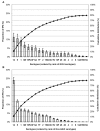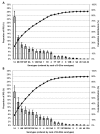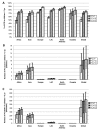Systematic evaluation of serotypes causing invasive pneumococcal disease among children under five: the pneumococcal global serotype project
- PMID: 20957191
- PMCID: PMC2950132
- DOI: 10.1371/journal.pmed.1000348
Systematic evaluation of serotypes causing invasive pneumococcal disease among children under five: the pneumococcal global serotype project
Abstract
Background: Approximately 800,000 children die each year due to pneumococcal disease and >90% of these deaths occur in developing countries where few children have access to life-saving serotype-based vaccines. Understanding the serotype epidemiology of invasive pneumococcal disease (IPD) among children is necessary for vaccine development and introduction policies. The aim of this study was to systematically estimate the global and regional distributions of serotypes causing IPD in children <5 years of age.
Methods and findings: We systematically reviewed studies with IPD serotype data among children <5 years of age from the published literature and unpublished data provided by researchers. Studies conducted prior to pneumococcal conjugate vaccine (PCV) introduction, from 1980 to 2007, with ≥12 months of surveillance, and reporting ≥20 serotyped isolates were included. Serotype-specific proportions were pooled in a random effects meta-analysis and combined with PD incidence and mortality estimates to infer global and regional serotype-specific PD burden. Of 1,292, studies reviewed, 169 were included comprising 60,090 isolates from 70 countries. Globally and regionally, six to 11 serotypes accounted for ≥70% of IPD. Seven serotypes (1, 5, 6A, 6B, 14, 19F, 23F) were the most common globally; and based on year 2000 incidence and mortality estimates these seven serotypes accounted for >300,000 deaths in Africa and 200,000 deaths in Asia. Serotypes included in both the 10- and 13-valent PCVs accounted for 10 million cases and 600,000 deaths worldwide.
Conclusions: A limited number of serotypes cause most IPD worldwide. The serotypes included in existing PCV formulations account for 49%-88% of deaths in Africa and Asia where PD morbidity and mortality are the highest, but few children have access to these life-saving vaccines. Please see later in the article for the Editors' Summary.
Conflict of interest statement
The authors have declared that no competing interests exist.
Figures




References
-
- World Health Organization. The global burden of disease: 2004 update. Geneva: World Health Organization; 2008.
-
- O'Brien KL, Wolfson LJ, Watt JP, Henkle E, Deloria-Knoll M, et al. The global burden of disease due to Streptococcus pneumoniae in children less than 5 years of age. Lancet. 2009;374:893–902. - PubMed
-
- Hausdorff WP, Bryant J, Paradiso PR, Siber GR. Which pneumococcal serogroups cause the most invasive disease: implications for conjugate vaccine formulation and use, part I. Clin Infect Dis. 2000;30:100–121. - PubMed
-
- Cherian T. WHO expert consultation on serotype composition of pneumococcal conjugate vaccines for use in resource-poor developing countries, 26–27 October 2006, Geneva. Vaccine. 2007;25:6557–6564. - PubMed
-
- World Health Organization. Global literature review of Haemophilus influenzae type b and Streptococcus pneumoniae invasive disease among children less than five years of age 1980–2005. Geneva: World Health Organization; 2009.
Publication types
MeSH terms
Substances
LinkOut - more resources
Full Text Sources
Medical

